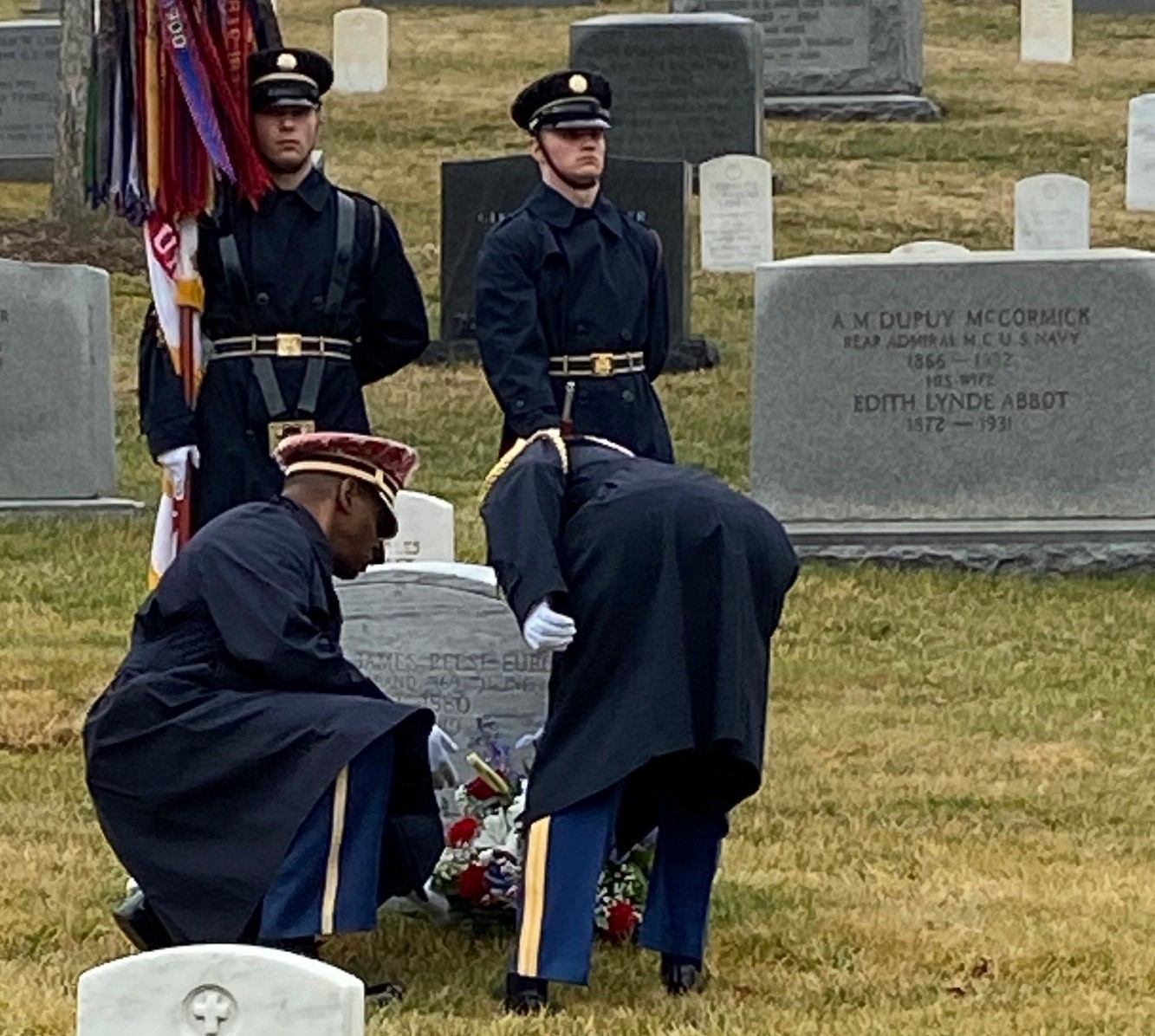On February 22, 2022, under grey skies and light rain, a small group of soldiers — some in black coats with gold lanyards and red service caps, others in World War I period “doughboy” uniforms — gathered at the grave of Lieutenant James Reese Europe (Section 2, Grave 3576). They were there for a ceremony to honor the anniversary of his birthday, in 1881. Europe, a renowned musical innovator, served as a Black officer in the segregated U.S. Army during World War I. He led the band for the 369th Infantry Regiment, the famed “Harlem Hellfighters.”

U.S. Army Band members and reenactors in World War I uniforms honor the legacy of Lt. James Reese Europe, who led the regimental band for the 369th Infantry Regiment. (Kevin M. Hymel)
Colonel Andrew Esch, the current commander of the U.S. Army Band, began the ceremony by calling Europe “one of the true founders of jazz music in America, but also a great soldier and leader.” Esch explained that Europe’s mission in World War I, as a bandleader, was the same as the Army Band’s today: to use music to inspire, communicate and break down social barriers.
Esch then introduced Lieutenant Jackel Smalls, the executive officer for the U.S. Army’s School of Music, who expanded on Europe’s life and service to his country. Smalls spoke about how Europe founded and led an all-Black orchestra, the Clef Club, which performed at New York City’s Carnegie Hall in 1912. Five years later, Europe and other Black citizens went to war, Smalls said, “for a country that sometimes did not appreciate them.” Commissioned as a lieutenant in the 369th Infantry, Europe commanded a machine-gun platoon in addition to leading the Hellfighters Band.
Even as Europe and other Black soldiers risked their lives for their country, African Americans served in a segregated military and faced racism both in the United States and abroad. In the U.S. military, they were generally relegated to non-combat roles, often loading cargo as stevedores or serving in labor battalions. The Black units that did enter combat were assigned to the French Army. Many Black soldiers bonded with the French, including Europe and his band, who attained popularity by playing music in French villages.
 Unlike the segregated Army in which Europe served, today’s military strives to equally include diverse service members throughout its ranks. As Smalls told the gathering at Europe’s gravesite, “We have leaders that are Black, White, Hispanic, Asian; we have men and women leading our formations. We also have folks from the LGBT community.” He then asked everyone to reflect on the legacy of Europe’s “leadership, his innovation and his courage in the face of adversity.”
Unlike the segregated Army in which Europe served, today’s military strives to equally include diverse service members throughout its ranks. As Smalls told the gathering at Europe’s gravesite, “We have leaders that are Black, White, Hispanic, Asian; we have men and women leading our formations. We also have folks from the LGBT community.” He then asked everyone to reflect on the legacy of Europe’s “leadership, his innovation and his courage in the face of adversity.”
Col. Andrew Esch (right) and another officer lay flowers at Lieutenant James Reese Europe’s grave. (Kevin M. Hymel)
At the ceremony, three men dressed in World War I uniforms stood out from the group. “We are a live reenactment of the 369th Regiment,” explained Specialist Christian Adkins of the 257th Army Band. The men dressed as “doughboys” were part of The 369th Experience, an organization which plays period music and raises public awareness of the band and its leader. “It’s special to be able to be connected to someone who has done so much for the military, for bands and just for music,” explained Adkins.
The ceremony showed how important Europe’s legacy remains to the Army and how a soldier in a segregated unit is still honored today for his music and leadership. The event concluded with Esch and another officer laying flowers at Europe’s grave. Although no jazz was played so as not to disrupt the quiet sanctity of the cemetery, a bugler did sound Taps.
For more about James Reese Europe and other African American innovators, explore our “African American Firsts” walking tour, part of Arlington National Cemetery’s Education Program.